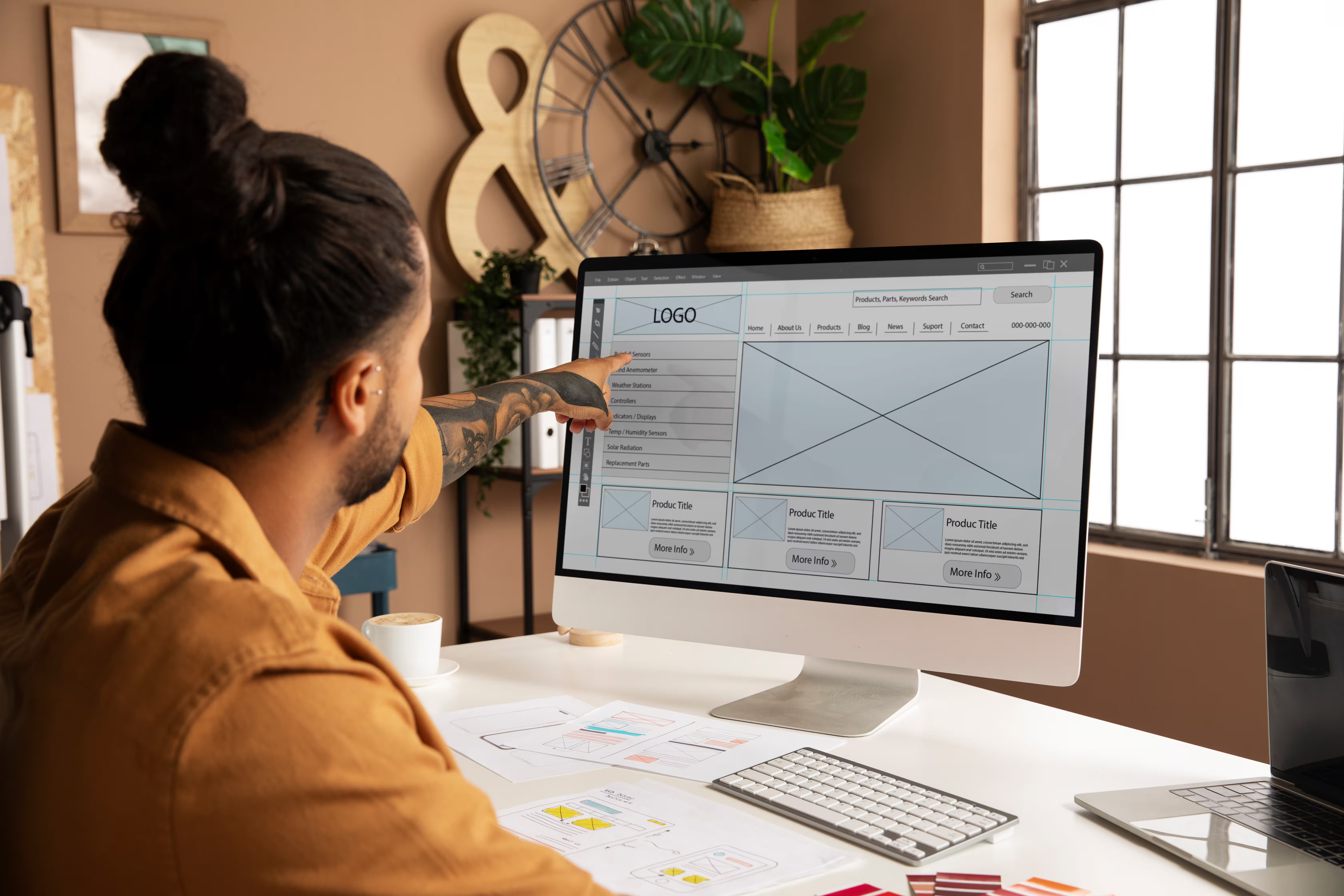Are you looking for the best tool to set up your store and start selling online? Webflow Ecommerce might be the right choice for you. The design process is very easy with no coding needed. You can make changes on your site in real time, without the hassle of downloading or uploading anything. Webflow also includes features like analytics that show how well your store is doing and a user-friendly dashboard to keep your things neat. Stick around and find out if this is what you're looking for.


What is ecommerce?
Before we jump into the guide, let's make sure we understand the basics. What does ecommerce even refer to? Investopedia defines ecommerce as a business model where companies buy and sell goods over the internet. In 2023, nearly every service or product is available online, making brick-and-mortar businesses obsolete.

The ecommerce industry skyrocketed during the pandemic and is currently one of the hottest industries out there. Sales reached almost $900 billion in the US alone in the year 2021. This is a 14.2% increase over 2020 and a 50.5% increase over 2019 according to Forbes. The global ecommerce market totalled over $5.5 trillion in 2022. Almost 60% of users browsing the internet buy something at least once per week. All in all, ecommerce is booming and there are no signs it will slow down any time soon.
To join this trend and get noticed in the fierce competition, you'll need a website that stands out. It's your first point of contact with your customers, where all the ecommerce selling and buying happens. With the industry growing so fast, it's really hard to get ahead. So this is where Webflow comes into play, allowing you to create an outstanding user experience.
What is Webflow?
Webflow is a visual website editor, allowing you to build fully flexible and responsive sites without ever writing a single line of code. Designers get the power of CSS, HTML and JavaScript in an easy-to-use canvas. With underlying code still accessible, Webflow allows complete design freedom and it goes even further. It can handle hosting, security and website performance itself.

Put it simply, Webflow is a user interface for front-end development. You build your site in a visual canvas and semantic code is generated under the hood. What sets Webflow apart from other platforms is that it's not just template-based. It's completely custom and enables you full creative freedom. You can customize even the tiniest element on the site. Webflow offers a wide array of features, but today we'll focus on just one. Read on and learn all about the Webflow Ecommerce and how it can help you get ahead of your competition.
How Webflow Ecommerce works
Like we said in the introduction, Webflow offers you amazing creative freedom. No other platform or website builder allows anything like what Webflow can do in terms of customization. With Webflow Ecommerce, you can design and build online stores, customize every detail of your cart and checkout experience and handle products and orders.
And this is super important in ecommerce because it means you can make the look, feel, brand and customer experience of your site unique to you and your business. There's more competition out there than ever before, so your website must really stand out.
Easy to integrate third-party tools and apps
Webflow offers quite a collection of widgets and plugins to enhance your website and improve its functionality. Besides this, there are already a lot of third-party tools integrated by default. You can find a bunch of integrations in the Webflow library, from analytics and anti-spam to ecommerce, localization and payment processing. Some of the common Webflow ecommerce integrations are:
All those integrations can automate your workflow and improve your customer retention. And here you can learn more about 6 must-have Webflow integrations for your business.

Customize the cart and checkout experience
Webflow is all about creating unique customer journeys. So it's only natural to be able to customize cart, checkout and order confirmations on your site.
Not only that you can create a unique cart button, but you can also customize the cart itself. You can specify the cart type, customize the animation and style different cart states. Styling your cart for how it appears in the default, error and empty state will improve the user experience.

After you are done with this, you can also customize your checkout flow and page. You can customize the checkout page by reordering and styling components and elements. You can even customize the PayPal checkout separately from the card checkout. Webflow University covers all the tips on how to do this.
User-friendly and versatile CMS
Editing content in Webflow is a breeze with its own CMS system. CMS enables you to add dynamic content to a website without touching any code. When editing in Webflow, you don't have to preview your site all the time to see every change you make on the website. The editor presents the page almost exactly as it looks life, so you can work with the page itself and not some distorted version of it.
By using CMS, you can create CMS collections and items. A collection is a specific content type such as blog posts for example. Each collection is then made up of fields (text, images, publish date, etc.). Each blog post is an item within the blog collection. Simply put, with CMS collection you can create just one design template for each of your collections.

This works pretty similarly in creating your ecommerce collections. They are created for you once you enable ecommerce for a project. You can edit the settings of these collections to customize and enrich them with custom fields. Collection templates pages allow you to smoothen this entire process.
Customize your shop layout
It has long been known that people buy with their eyes. This report shows that more than 60% of consumers say that pictures are more important than the product description. Colors are proven to increase people's willingness to read a piece of content by 80%.
Customizing your shop layout and gallery page can really pay off. Creating a beautiful customer journey will help users have a seamless interaction with your site. This will lead to better conversion and more sales. To help you get some inspiration, here is a list of 25 ecommerce website examples in 2023.

Design your transactional emails
Webflow allows keeping your branding consistent through all customer touchpoints. You can keep your branding consistent by sending transactional emails. You can set the brand color, choose the background and upload your logo. You can also personalize every single email with the help of dynamic fields.

Besides making your email custom, Webflow also allows you to manage your whole marketing lifecycle. You can add forms to collect emails and then connect your site to Mailchimp to run email campaigns.
Build custom interactions and animations
In this year and age, websites are no longer static. Adding custom interactions and animations don't just help you stand out but also enhance the user experience. Webflow enables you to add those animations without writing code. You can create effects like parallax, precise reveal animations and progress bars. You can also create micro-interactions that shift and move as you hover over the elements.

The best thing is that you don't even have to create those animations alone. There are more than 20 preset interactions and animations you can add to your site in just a few clicks.
Pricing
Setting up Webflow Ecommerce is not the cheapest. You can choose among three different pricing tiers (standard, plus and advanced). The standard plan starts at $29/month (billed yearly) and adds a 2% transaction fee. The plan also includes all CMS plan features, enabling you to list 500 items, a customizable shopping cart and a shopping portal.
If you want to eliminate the 2% transaction fees, you have to upgrade to the Plus plan. The plan starts at $74/month (billed yearly) with no transaction fee. The plan also supports 5.000 ecommerce items and enables you to use all business plan features.
The last and the most expensive plan starts at $212/month (billed yearly), also with no transaction fee. You also get all Plus plan features and 15.000 ecommerce items.

Conclusion
Ecommerce has been on the rise for quite some time now and Covid-19 gave an extra boost to the whole industry. According to Statista, the percentage of customers who made at least one purchase online in 2021 skyrocketed. The number grew to 74% in the US, 81% in the UK and 69% in China. According to a Shopify report, global ecommerce sales are expected to reach more than $7 trillion by 2025.
Knowing those facts, it's a no-brainer to join the game and build your ecommerce site. While Webflow is not the cheapest option, its heavy emphasis on design can help you stand out from the crowd. Webflow allows you to customize everything from your store layout to sending transactional emails. Here are a few great examples of custom Webflow ecommerce sites: Nalen Ayurveda, Cloe Cassandro, etc.

In the end, Webflow is an attractive solution and a strong alternative to other website builders. It will give you flexibility, it's easy to use and will help you stand out. But if you are still not sure, check out our blog posts on how to Webflow compares to Shopify or WordPress.
Frequently asked questions
Can I use Webflow for ecommerce?
Yes, you can use Webflow for ecommerce. Webflow has three different pricing tiers that you can choose from and set up a fully customized online store.
Is Webflow ecommerce worth it?
Yes, Webflow ecommerce is worth it. Webflow has all the essential features needed to run a fully functional online business. While it doesn't have as many functions as Shopify, it offers you more creative freedom. So if having a fully custom ecommerce site is your priority, Webflow is well worth it.
Can I use WooCommerce with Webflow?
Yes, you can use WooCommerce with Webflow with the help of Udesly.




















